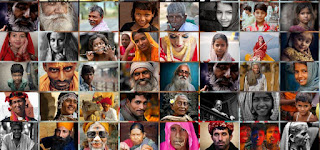India is a highly diverse country with a rich tapestry of people and society. The people of India belong to various ethnic groups, speak different languages, and practice a variety of religions. Here are some key aspects of the people and society of India:
Ethnic Diversity: India is home to a vast array of ethnic groups. The population includes Indo-Aryans, Dravidians, Mongoloids, and various indigenous tribal communities. Each group has its own unique customs and traditions.
Languages: India is a linguistically diverse nation with hundreds of languages spoken across the country. Hindi and English are the official languages, but each state has its own official language. The Constitution of India recognizes 22 languages as scheduled languages.
Religions: India is the birthplace of several major religions, including Hinduism, Buddhism, Jainism, and Sikhism. In addition to these, there are significant populations of Muslims, Christians, and other religious groups.
Caste System: The caste system has historically played a significant role in Indian society. While there have been efforts to combat caste-based discrimination and promote equality, it remains a social issue in many parts of the country.
Family Structure: Indian society places great importance on the family unit. Extended families often live together and provide a strong support system. Traditional values, respect for elders, and family cohesion are highly regarded.
Gender Roles: Gender roles in India vary by region and culture. While women have made significant strides in various fields, gender disparities still exist, particularly in rural areas.
Social Hierarchies: Social hierarchies, such as those based on caste and class, have historically played a role in Indian society. Efforts to promote social equality and affirmative action for marginalized groups have been made.
Festivals and Traditions: India is known for its diverse festivals and traditions. Each state and region has its own unique celebrations and rituals, from Diwali and Holi to Eid and Christmas.
Marriage and Arranged Marriages: Arranged marriages are common in India, with families often playing a central role in choosing a spouse. Love marriages are also becoming more common, especially in urban areas.
Education and Literacy: India has made significant progress in improving literacy rates and access to education. However, disparities still exist, particularly in rural areas and among marginalized communities.
Cuisine: Indian cuisine is incredibly diverse, with regional specialties and a wide range of vegetarian and non-vegetarian dishes. Spices and flavors vary by region.
Art and Culture: India has a rich cultural heritage, including classical dance forms, music, art, and architecture. The country has produced renowned poets, writers, and artists.
Diversity of Dress: The clothing worn in India varies widely depending on the region and culture. Traditional attire like sarees, dhotis, and turbans are still commonly worn, while Western clothing is also prevalent.
Urbanization: India has seen rapid urbanization in recent years, with a significant portion of the population living in cities. This has led to shifts in lifestyle and occupation patterns.
Challenges and Opportunities: India faces challenges such as poverty, healthcare disparities, and environmental issues. However, it also presents numerous opportunities for growth and development.
.webp)

Comments
Post a Comment